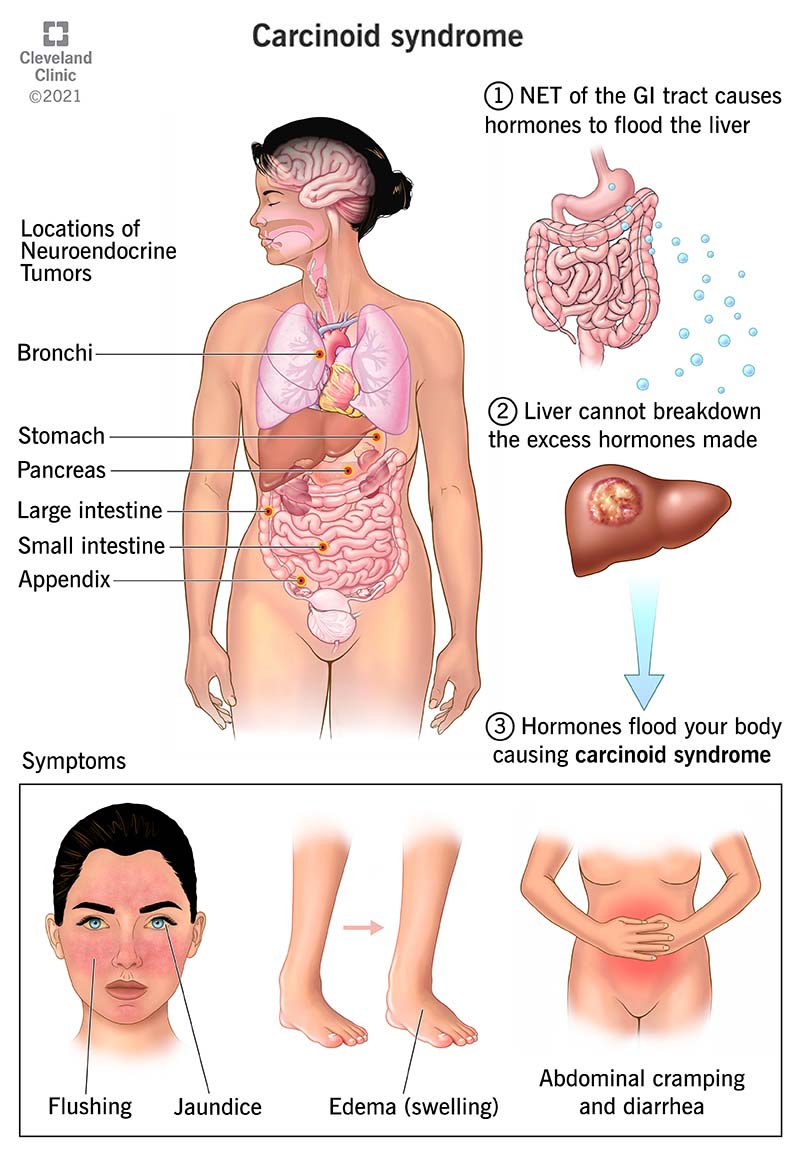Carcinoid syndrome may be a complication of neuroendocrine tumors (NETs). NETs are rare tumors that start in your neuroendocrine cells. Carcinoid syndrome often affects people with NETs in their lungs or digestive system. Carcinoid syndrome symptoms include diarrhea, flushing and wheezing.
Advertisement
Cleveland Clinic is a non-profit academic medical center. Advertising on our site helps support our mission. We do not endorse non-Cleveland Clinic products or services. Policy

Carcinoid syndrome is a rare condition that happens if you have neuroendocrine tumors. Neuroendocrine tumors (NETs) are tumors that start in specialized cells in your neuroendocrine system.
Advertisement
Cleveland Clinic is a non-profit academic medical center. Advertising on our site helps support our mission. We do not endorse non-Cleveland Clinic products or services. Policy
NETs develop when your neuroendocrine cells begin to rapidly divide and multiply, creating tumors that release unusually large amounts of serotonin and other substances. When that happens, you develop carcinoid syndrome symptoms. Sometimes, a carcinoid syndrome diagnosis is the first indication you have a neuroendocrine tumor.
Very rarely, people with carcinoid syndrome have carcinoid crises, a potentially life-threatening condition that can happen if your carcinoid syndrome goes undiagnosed or untreated.
No, it’s not. One study suggests 1 in 5 people with neuroendocrine tumors (NETs) have carcinoid syndrome, and NETs affect about 5 in 100,000 people in the United States.
Studies suggest the most common symptoms include:
Advertisement
Carcinoid syndrome happens if you have neuroendocrine tumors. This refers to symptoms that develop from tumors in specialized cells in your neuroendocrine system that make and release hormones. While you can have NETs in your gastrointestinal tract, lungs and pancreas, carcinoid syndrome typically happens when NETs in your gastrointestinal tract or lungs flood your system with hormones.
The most common risk factor is having a neuroendocrine tumor in your gastrointestinal tract or your lungs.
Carcinoid syndrome may cause several kinds of complications, including carcinoid crises, which can be life-threatening.
Other carcinoid syndrome complications include:
Carcinoid crisis is an extremely rare but life-threatening condition. Triggers for this include surgery or other medical procedures or traumatic events like an injury from an accident. Carcinoid crisis symptoms include:
People with carcinoid syndrome or a neuroendocrine tumor should carry a card listing their medical condition in case they need emergency medical care. Likewise, people with carcinoid syndrome or an NET who are planning to have surgery should make sure their providers know about their condition. Providers can administer medication before and during surgery to reduce carcinoid crisis risk.
Healthcare providers may use the following tests to diagnose carcinoid syndrome:
Advertisement
Neuroendocrine tumors cause carcinoid syndrome, so treating the tumors also treats the syndrome.
Those treatments include:
No, it can’t be prevented. Carcinoid syndrome is linked to neuroendocrine tumors, and as there isn’t a known way to prevent NETs, there’s no way to prevent its symptoms.
If you have carcinoid syndrome, you probably also have a neuroendocrine tumor. If you have carcinoid syndrome symptoms, tell your healthcare provider. They’ll be able to assess your situation and recommend tests to determine if you have an NET.
The three main carcinoid syndrome symptoms are flushing, wheezing and diarrhea. Here are some suggestions for managing the main symptoms:
Advertisement
You should see your healthcare provider if your carcinoid syndrome symptoms get worse. If you’re receiving treatment for a neuroendocrine tumor, let them know if you notice changes in your body that feel like NET symptoms. These changes might be unrelated to your NET diagnosis, and the best way to be sure of that is to talk to your provider. You should also contact your provider if your symptoms or treatment side effects become worse.
Carcinoid syndrome symptoms get worse over time if untreated and can become a life-threatening condition called carcinoid crisis. Go to the emergency room if:
Advertisement
Carcinoid syndrome might be a sign you have a neuroendocrine tumor. While you’ll have questions about carcinoid syndrome, you’ll probably have more questions about NETs. Here are some questions you might want to ask your healthcare provider:
Carcinoid syndrome is a rare condition that happens if you have a neuroendocrine tumor or NET. In most cases, people with carcinoid syndrome already know they have an NET. Other times, a carcinoid syndrome diagnosis is how people learn they have a neuroendocrine tumor. You can get treatment for NETs. Learning you have carcinoid syndrome is your first step toward finding out if you have cancer and if you do, how to treat it. If you have a carcinoid syndrome diagnosis, ask your healthcare provider about next steps to confirm potential NETs.
Neuroendocrine tumors often have symptoms that are similar to other conditions and leave you wondering what’s wrong. Cleveland Clinic can help find the answers.

Last reviewed on 06/14/2023.
Learn more about the Health Library and our editorial process.